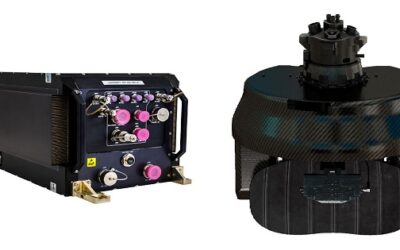The UK is fusing its cyber and electronic warfare doctrines, while questions remain concerning the British Army’s Landseeker programme
110 years ago the British Army raised the Royal Engineers Signal Service. Two years later, this would form the Royal Corps of Signals. The Corps remains part of the British Army providing communications support to the force, operating and maintaining its telecommunications and information systems and performing Electronic Warfare (EW). With the Corp’s centenary looming in two years, it is a good moment to examine the role of EW in British Army doctrine.
CEMA
Official army and UK Ministry of Defence (MOD) documents provide an insight on how the force about EW, and how it would use such capabilities in anger. One MOD source told the author that “(EW) is integrated into the spectrum of army, and wider (MOD capabilities) as part of the range of effects available to support both land and joint operations,” adding that: “Specific doctrine supporting the use of EW is classified.”
This February to little fanfare the MOD’s Development, Concepts and Doctrine Centre published Joint Doctrine Note 1/18: Cyber and Electromagnetic Activities. In its own words, the publication attempted “to capture the widest concept of Cyber and Electromagnetic Activities (CEMA) and draws together elements of existing doctrine and best practice.” Arguably reflecting on seven years of conflict in Syria, and Russia’s intervention in the Ukrainian civil war from 2014, the document makes a stark observation: “To succeed against complex and diverse threats that exploit the pervasive information environment we need to do things differently.” Hostilities in Ukraine and Syria have underscored that battlefield signals intelligence has arguably moved beyond existing doctrines which stressed capturing Communications Intelligence (COMINT) and to a lesser extent Electronic Intelligence (ELINT) regarding hostile military communications and ground-based radars, towards an environment where telecommunications traffic zooming around the battlefield across smartphones and tablets using civilian GSM (Global System for Mobile Communications) protocols is as much a threat to friendly operations. Russia’s use of EW during its Ukraine intervention is highly instructive. Roger McDermott, senior fellow in Eurasian Military Studies at the Jamestown Foundation think tank in Washington DC, stated in his seminal September 2017 publication, that the Russian Army’s Orlan-10 Unmanned Aerial Vehicle (UAV) had been used during the Syria intervention to send misleading text messages to cellphones as part of the force’s psychological operations (psyops).
A similar trend, Mr. McDermott continued, was observed during the Russian annexation of Crimea in February/March 201’ where Russian EW units transmitted text messages to Ukrainian troops’ cellphones with the aim of undermining morale: “Such pysops and EW integration may not have been on a wide scale, but it certainly took place sporadically.” Russian EW practioners and the army in general will have learnt lessons from the Crimea and Syrian interventions. Thus future Russian military adventures may include a far higher and frequent level of coordinated EW and psyops. Much as conventional military communications are the vector by which orders and plans are transferred into action, civilian telecommunications are the vectors by which an adversary’s psyops are conveyed. Both are to be effectively countered if an army is to prevail on the battlefield, hence the gradual convergence of EW and cyber operations in land EW doctrine.
Judging by the trajectory of Joint Doctrine Note 1/18 this appears to be something that the British Army, the MOD and the UK’s intelligence community are increasingly aware of. In fact, the doctrine explicitly states that “Russian operations in south-eastern and eastern Europe highlighted the effectiveness of synchronising CEMA with conventional operational activities to shape both the adversary’s and international perception. However, within the North Atlantic Treaty Organization (NATO) and specifically UK doctrine, force and capability development have not kept pace.”
Doing things differently, as the publication articulates, rests on being adaptable which in turn means having a “doctrine that examines how we adapt operations to the changing environment rather than trying to control it. This is the context within which (the MOD) must undertake CEMA.” The doctrine acknowledges that as far as the UK armed forces are concerned, EW has to an extent been stove-piped, even when UK forces have been operating jointly and that recent British EW efforts have primarily supported counterinsurgency and stabilisation operations. This has perhaps been most immediately apparent during British operations in Iraq and Afghanistan earlier this century where the need to detect and neutralise radio-triggered improvised explosive devices, and gather COMINT on insurgent activities and intent has been paramount. Nonetheless the army and the UK armed services are moving towards an increasingly ‘purple’ approach to EW, as enshrined in the doctrine, and other official publications. The MOD source continued that: “EW is incorporated in joint and army doctrine; Army doctrine for electronic warfare is entirely coherent with respective RAF and Royal Navy doctrine to fully complement joint effects. Similarly both UK Joint and Army EW doctrine is itself fully coherent with NATO doctrine.”
The MOD’s Future Force Concept published in July 2017 provided the bedrock upon which the joint doctrine’s approach to CEMA was built. The former was published as a template for the direction of the future force structures of the British armed forces and their accompanying investment decisions, recognising the increasingly joint nature of the operational environment into which these services will deploy. Reflecting the Cyber/EW convergence, the concept posits that “Cyber and electromagnetic activities are interdependent,” continuing that future conflicts will see EW and cyber-warfare used to contest each of these domains; i.e. Electronic Attack (EA) being brought to bear against wifi networks, for example, and cyber attack used to potentially jam EW systems or infect Electronic Support Measures (ESMs) such as ELINT databases. It goes on to place a premium on the fusion of ELINT and cyber intelligence gathering noting that: “Standing cyber and (electromagnetic) survey data will enable intelligence, surveillance and reconnaissance … to help us identify adversary activity and support control of our own use of the (electromagnetic spectrum).” Above all, for the British Army and the UK’s armed forces: “Freedom to use parts of cyberspace and the electromagnetic environment flexibly and to deny, degrade or constrain adversary access will offer significant competitive advantage.”
Landseeker
How is the MOD’s CEMA vision likely to affect the British Army? Tellingly, the army’s Land Operations Doctrine includes a discussion on cyber operations into which a discussion of EW’s role is subsumed. This reflects the fusion of cyber and EW apparent in MOD thinking: “Cyberspace pervades all operations and so responsibility for exploiting its potential and protecting from its threats is common to all components.” Crucially it emphasises that “cyberspace and the electromagnetic environment must be considered together.” Operationally, the doctrine underscores that the full application of cyber and EW activities will be planned and coordinated at the divisional level and above, with lower echelons performing specific CEMA actions as a response to the divisional commander’s intent: “In all cases, land forces must consider the effects of cyberspace and the (electromagnetic environment) on their particular operational environment and the actors within it,” the doctrine stresses.
The army’s CEMA posture will be executed by the cyber and EW tools at its disposal. Over the past five years there was much discussion in the specialist media of the British Army’s Landseeker programme. This was intended to revitalise the force’s Signals Intelligence (SIGINT) collection. The programme was said to be worth between $160 million and $400 million (in 2014 values), and it followed the demise of Lockheed Martin’s Soothsayer initiative which was axed in 2009. The scope of Soothsayer was to provide a SIGINT (ELINT and COMINT) capability along with a communications EA function using manpack and vehicular systems. The equipment was to have furnished the British Army’s Rapid Reaction Force and 30 Commando Information Exploitation Group of the Royal Marines’ 3 Commando Brigade. Cost increases by $61 million as determined by the UK’s National Audit Office, which scrutinises government spending, appeared to have sealed Soothsayer’s fate.
Few details publicly exist regarding the prospective Landseeker architecture, its capabilities or procurement timelines. Nevertheless, highly placed sources within the UK land forces EW community told the author that the programme appears to have been suspended and that no additional MOD funds have been forthcoming to move it forward. The source continued that they would not be surprised if the programme was shelved altogether.
Capabilities
Another MOD official told the author that “the exact quantities and types of equipment used (for EW) are classified, as are any projects to upgrade existing, or to develop, new capabilities ” That said, official documents seen by the author provide an interesting overview of British Army land EW capabilities. Several systems are deployed to assist British Army SIGINT gathering and EA efforts. For example, Chemring’s Resolve manpack and vehicular systems, open sources state, can perform both ESM and EA. Resolve is thought to cover a frequency range of three megahertz/MHz to at least three gigahertz/GHz (possibly extending to six gigahertz); which allows it to cover an array of tactical communications in the High Frequency (HF), Very High Frequency (VHF) and Ultra High Frequency (UHF) wavebands offering 40 megahertz of instantaneous bandwidth. These systems can be either used in isolation or networked. There appears to be some confusion regarding the British Army’s Scarus man-pack COMINT system believed to be in British Army service. Some sources state that Scarus is the army’s designation for Resolve, others note that it is a separate system. The latter maybe closer to the truth as Scarus appears to have slightly different capabilities from Resolve. It reportedly covers a 0.5MHz to two gigahertz waveband, performing the interception or single channel, frequency-hopping/spread spectrum and basic data communications across this waveband with the ability to DF (Direction Find) communications across a waveband of 0.5MHz to 1.8GHz. Depending on the terrain, Scarus is reportedly capable of intercepting signals at ranges of between ten kilometres/km (6.2 miles) to 20km (12.4 miles).
The COMINT capabilities of Resolve and Scarus are enhanced with the Quick Reaction Survey Capability (QRSC). This vehicular system is capable of covert operations and can perform ELINT gathering regarding HF/VHF/UHF communications. British Army documents continue that the QRSC is typically organic to deployed land forces, although generally QRSC intelligence is gathered for what are euphemistically called ‘Other Government Departments.’ This is understood to include the British domestic and foreign intelligence communities, and may see QRSC COMINT shared with organisations such as the Government Communications Headquarters which performs SIGINT gathering for British government. This would make sense as British involvement in recent US-led interventions in the Iraqi and Afghan theatres would have needed to gather COMINT not only in support of the manoeuvre force, but also to help operational and strategic counter-terror efforts, hence the need to gather COMINT for non-military intelligence organisations. Documents continue that intelligence gathered by the QRSC usually receives British STRAP classifications; the codename for high level intelligence requiring dedicated protocols for its transport and handling, and believed to be restricted to UK nationals.
Beyond COMINT, the British Army uses the vehicular Thales INCE/Meerkat-S. This is tasked with the collection of ELINT from naval, airborne and ground-based radars. Open sources state that the INCE/Meerket-S system covers a waveband of 400MHz to 18GHz providing a 1.5 degree bearing accuracy, 360 degrees of surveillance and 30 degrees of elevation coverage. It is said to be capable of tracking up to 500 emitters simultaneously and can retain up to 10,000 emitter mode records in its main library with a further 1,000 records in its auxiliary library. Thales claims that the system has a 100 percent probability of interception within two seconds.
Finally, in terms of army-owned airborne COMINT the force can make use of Britten-Norman Defender/Islander family turboprop reconnaissance aircraft. These are known to possess a COMINT capability and are flown by the Army Air Corp’s 651 Squadron. Very little is known about the specific capabilities of these aircraft although it is reasonable to assume that they can at perform V/UHF COMINT gathering. Two of the army’s Islander-CC2/2A aircraft are routinely deployed from RAF Northolt airbase in west London to gather COMINT on high value individuals in the UK. In this role, they will almost certainly be capable of gathering cellphone COMINT across the 800MHz to 2.6GHz UK cellular wavebands. Meanwhile in September 2017, the MOD announced that the force’s Thales WK-450 Watchkeeper UAV had received QinetiQ’s AS3 COMINT payload. Precise details on the AS3’s performance are sparse, although open sources state that it can geolocate V/UHF transmissions. Importantly, the MOD is enhancing its EW database. The Project Shephard initiative, launched in 2008 in the words of the MOD will “significantly improve the fidelity of data and associated programming capabilities to enable the delivery of improved EW operational support,” across the UK armed forces. In a nutshell, sources inform the author that this will allow all services to contribute SIGINT to the Project Shephard database and use the SIGINT it contains to support its own operations.
Next Steps
While there will be individuals in the MOD, British Army and in the UK defence community whom are highly concerned regarding the potential demise of Landseeker, it is possible that new capabilities which have entered service in recent years, such as Resolve and AS3, plus the advent of Project Shephard, could mitigate its loss. This could be achieved by enabling the more efficient collection and use of SIGINT not only to support British Army CEMA operations, but to support UK CEMA doctrine writ large.

























